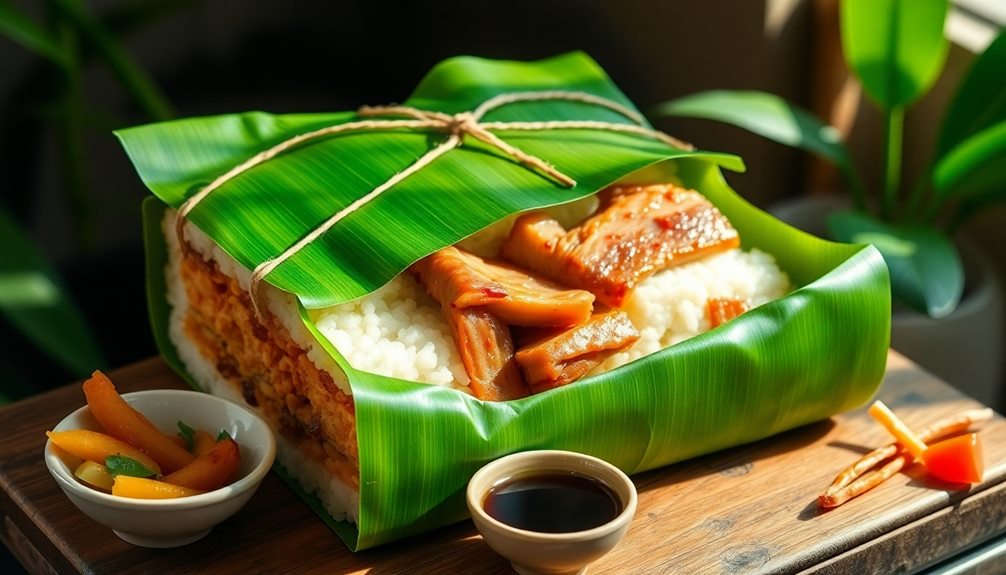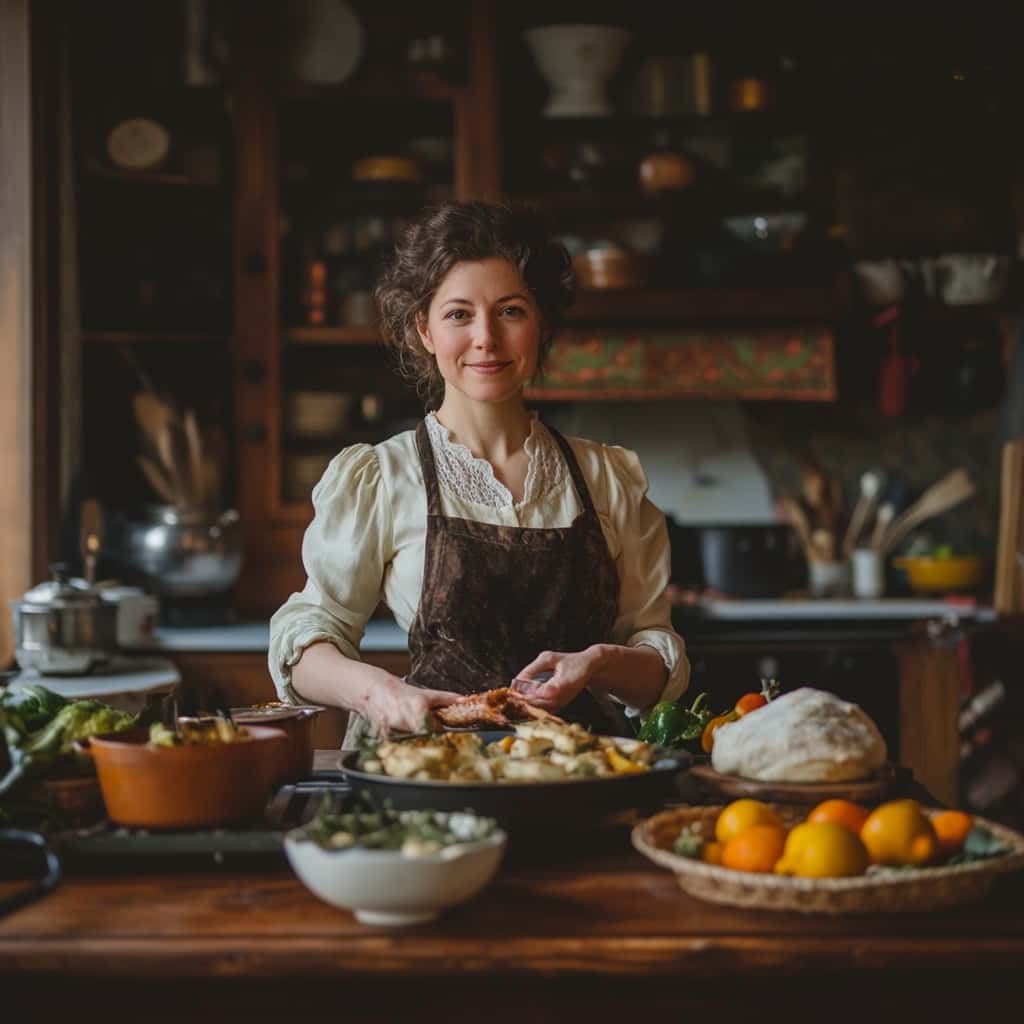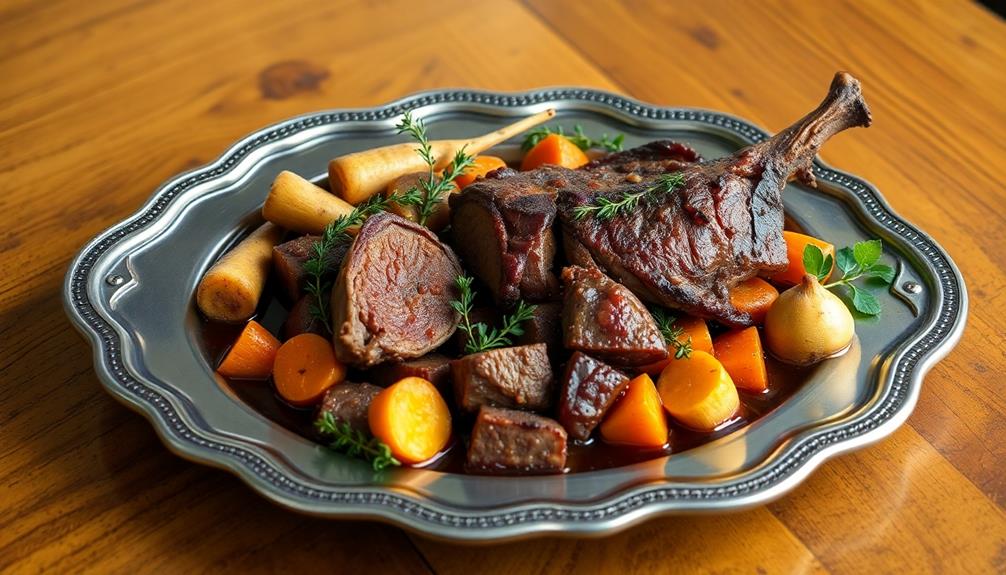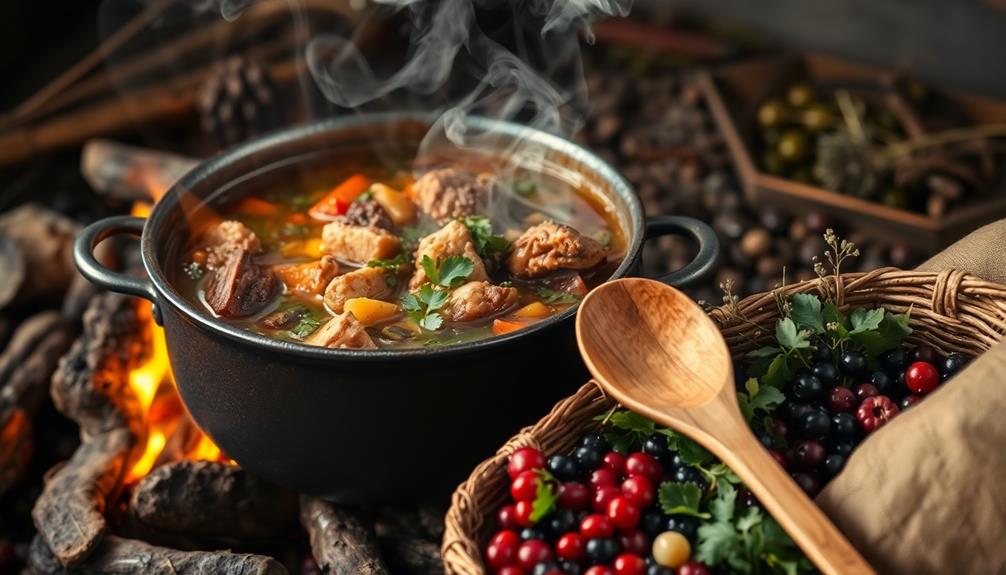Ancient Roman cuisine takes you on a flavorful journey through the empire's diverse culinary influences. Discover the pungent umami of garum, a fermented fish sauce that seasoned countless dishes. Indulge in the decadence of roasted dormice, a delicacy for the aristocracy. Savor the creativity of savory meat patties like Isicia Omentata, showcasing the ingenuity of ancient Roman cooks. From the symbolic meanings of certain foods to the advanced preparation techniques, this rich culinary heritage offers a glimpse into the cultural fabric of the Roman world. Explore further to uncover the intriguing stories behind these forgotten flavors.
Key Takeaways
- Garum, a fermented fish sauce, was a ubiquitous seasoning in ancient Roman cuisine, providing a unique savory umami flavor.
- Dormice were considered a delicacy among the wealthy, often cooked in olive oil, vinegar, and herbs.
- Roman cuisine reflected the diverse cultural influences of the Roman Empire, integrating ingredients and cooking techniques from conquered regions.
- Hosting grand feasts was a social ritual that showcased status and strengthened community bonds among the upper classes.
- Rediscovery of ancient Roman recipes and ingredients offers modern culinary enthusiasts opportunities to explore forgotten flavors and reconnect with cultural heritage.
History
The culinary traditions of ancient Rome can be traced back to the early days of the city's founding. As Rome's power and influence grew, so too did its cuisine, drawing inspiration from the diverse cultures and regions it conquered.
From the simple peasant dishes of the rural countryside to the extravagant banquets of the aristocratic elite, Roman cuisine was a reflection of the empire's complex social hierarchy.
Garum, a fermented fish sauce, was a ubiquitous ingredient, adding a savory depth to countless dishes. Likewise, the Romans' fondness for exotic meats, such as dormice and peacocks, was a testament to their adventurous palates and desire to showcase their wealth and status.
Over time, the culinary influences of Greece, Gaul, and other conquered lands were seamlessly integrated into the Roman repertoire, creating a rich and diverse culinary tradition that would shape the way we think about food to this day.
Recipe
Roman cuisine was heavily influenced by the diverse cultures and regions that made up the vast Roman Empire. One popular dish from this era was Isicia Omentata, a savory meat patty flavored with spices and herbs.
To prepare this ancient Roman delicacy, you'll need to source some unique ingredients that may be challenging to find in modern times. However, the end result is a flavorful and historically-inspired dish that will transport you back to the glory days of the Roman Empire.
Ingredients:
- 1 pound ground pork
- 1 egg
- 1/2 cup bread crumbs
- 1 tablespoon ground pepper
- 1 tablespoon cumin
- 1 tablespoon coriander
- 1 teaspoon garum (or fish sauce)
- 1/4 cup dry white wine
In a large bowl, combine the ground pork, egg, bread crumbs, pepper, cumin, coriander, and garum. Mix well until fully incorporated.
Slowly add the white wine, mixing continuously, until the mixture forms a cohesive patty.
Form the mixture into small, oval-shaped patties. Heat a large skillet over medium-high heat and cook the patties for 3-4 minutes per side, or until golden brown and cooked through. Serve warm and enjoy this taste of ancient Rome.
When preparing Isicia Omentata, be mindful that the garum or fish sauceor fish saucemay be difficult to source. You can substitute with a high-quality fish sauce or try adding a bit of anchovy paste instead.
Additionally, the exact spice blend may vary based on regional influences, so feel free to experiment with different herbs and seasonings to suit your taste preferences.
Cooking Steps
First, prepare the garum, a savory Roman fish sauce, by fermenting fish and spices.
Next, cook the dormice in a rich sauce, then serve them alongside briny olives.
Step 1. Prepare Garum, a Roman Fish Sauce

Although garum was a staple condiment in ancient Roman cuisine, its preparation required patience and attention to detail.
Begin by selecting the freshest, high-quality fish. Typically, small, oily fish like anchovies or mackerel were used. Clean the fish thoroughly, removing the heads, scales, and internal organs.
Layer the fish and coarse salt in a large ceramic vessel, ensuring each layer is evenly distributed. Cover the vessel and let it sit in the sun for several months, stirring occasionally. As the mixture ferments, the fish will break down, releasing a rich, savory liquid – the prized garum.
Once the desired flavor is achieved, strain the mixture through a fine-mesh sieve, reserving the liquid. Discard the solids. Your garum is now ready to use as a seasoning, adding depth and complexity to a variety of ancient Roman dishes.
Step 2. Prepare Dormice in Sauce
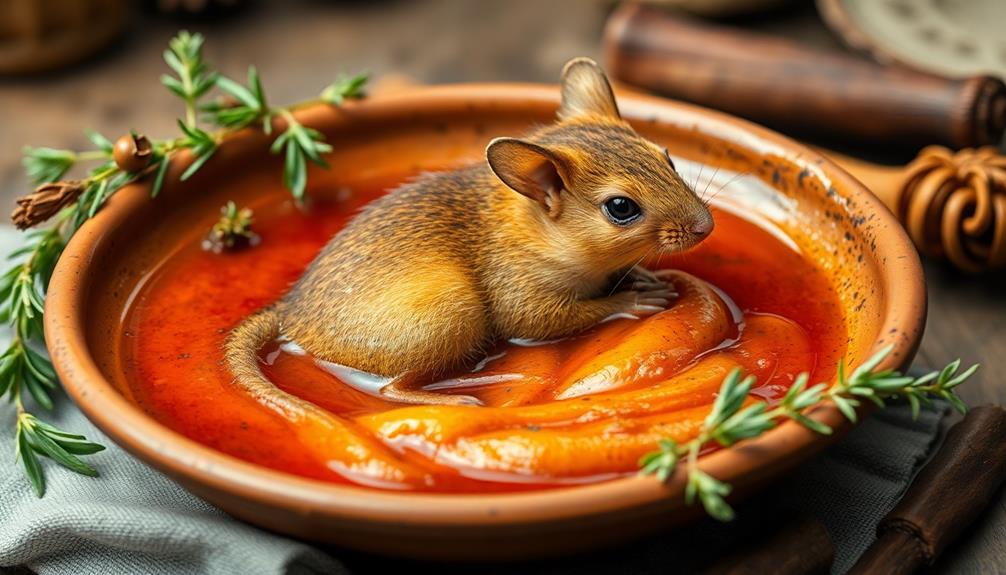
Gather the necessary ingredients: dormice, olive oil, vinegar, pine nuts, dates, and a selection of fresh herbs and spices.
Gently brown the dormice in olive oil, then remove from the pan. In the same pan, sauté the pine nuts until fragrant.
Add the vinegar, dates, and a splash of water, and simmer until the dates have softened. Carefully return the dormice to the pan, nestling them among the sauce.
Sprinkle in the fresh herbs and spices, such as rosemary, thyme, and black pepper, to taste. Cover and simmer for 15-20 minutes, or until the dormice are cooked through and the sauce has thickened.
Serve the dormice in sauce warm, accompanied by crusty bread to soak up the flavorful juices. This dish showcases the rich, savory flavors that were once enjoyed by the ancient Romans, a unique glimpse into the past.
Step 3. Serve Dormice With Olives

After savoring the rich flavors of the dormice in sauce, it's time to complement the dish with the briny tang of olives.
Carefully arrange the cooked dormice on a serving platter, then scatter a generous amount of pitted green and black olives around them. The contrast of the tender, succulent meat and the salty, aromatic olives creates a harmonious balance that tantalizes the palate.
Drizzle a bit of the savory sauce from the dormice over the olives, allowing the flavors to mingle. This simple addition enhances the overall experience, making each bite a delightful interplay of textures and tastes.
Don't be afraid to use your fingers to pick up the dormice and olives, as this was likely the traditional way of enjoying this ancient Roman delicacy.
Serve the dish warm, encouraging your guests to savor each flavorful morsel.
The combination of the dormice and olives will transport them back to the bustling streets of ancient Rome, where these unique culinary treasures were once savored with relish.
Step 4. Garnish With Fresh Herbs

To elevate the vibrant flavors of the dormice and olives, thoughtfully garnish the dish with a selection of fresh herbs. Torn leaves of fragrant rosemary and thyme add an earthy, piney note that complements the richness of the dormice.
Sprinkle chopped parsley over the top, its bright, grassy character cutting through the dish's intensity. For a touch of zest, finely grate lemon zest over the entire plate, its citrusy aroma awakening the senses.
Don't be afraid to experiment with other herbs as well. Thinly sliced mint leaves can lend a refreshing, cooling element, while a scattering of chopped oregano brings a subtle, peppery punch.
The key is to use the herbs judiciously, allowing their flavors to enhance the primary ingredients without overwhelming them. With a well-chosen herbal garnish, you'll transform this ancient Roman dish into a harmonious and visually appealing culinary masterpiece.
Step 5. Enjoy the Ancient Roman Feast

With your fresh herbs prepped and at the ready, it's time to bring this ancient Roman feast to life. Gather your guests and invite them to recline on low couches around a bountiful table. Offer them cups of watered-down wine or spiced vinegar to whet their appetites.
Begin the meal with a course of small bites – olives, cheese, and flatbread, seasoned with your fragrant herbs.
Next, serve the main dishes – a savory pork and vegetable stew, roasted chicken with a tangy sauce, and a platter of sautéed dormice, a delicacy in ancient Rome.
Don't forget to incorporate the tangy, umami-rich garum sauce, a Roman staple, into your preparations.
End the feast with fresh fruit, honey-sweetened cakes, and more watered-down wine. Encourage your guests to engage in lively conversation and enjoy the flavors of this ancient culinary experience.
The rhythmic sounds of laughter and clinking cups will transport you back to the glory days of the Roman Empire.
Final Thoughts
Ancient Roman cuisine offers a fascinating glimpse into the culinary traditions and preferences of one of history's most influential civilizations. From the ubiquitous garum to the indulgent dormice, these flavors and dishes transport us to a bygone era, where dining was as much a social event as it was a necessity.
As we've explored the vibrant tapestry of Roman culinary history, it's clear that their palates were as diverse as the empire itself, embracing both the familiar and the exotic.
While some of these culinary practices may seem peculiar or even unsavory by modern standards, they reflect the ingenuity, resourcefulness, and cultural richness of the Roman world.
By understanding and appreciating this ancient cuisine, we can gain a deeper appreciation for the complexities of human history and the ever-evolving nature of our relationship with food.
As you reflect on this journey through Ancient Roman cuisine, remember that the past can often inspire us to expand our own culinary horizons and rediscover long-forgotten flavors.
Frequently Asked Questions
What Were the Typical Dining Etiquette Practices in Ancient Rome?
In ancient Rome, dining etiquette was essential. You'd recline on couches, use your fingers to eat, and share dishes with others. Conversation and entertainment were integral parts of the meal.
How Did the Social Class of Ancient Romans Affect Their Diets?
The social class of ancient Romans greatly impacted their diets. Wealthy Romans enjoyed diverse, lavish meals, while the poor primarily subsisted on basic grains and vegetables. Your social status determined the quality and variety of food you could access.
What Were the Most Common Kitchen Tools and Equipment Used in Ancient Rome?
As an ancient Roman, your kitchen would have included a variety of tools, like mortars, pestles, knives, pots, and pans. These were essential for preparing the diverse range of dishes in your daily diet.
How Did the Availability of Ingredients Vary Across Different Regions of the Roman Empire?
The availability of ingredients across the Roman Empire varied greatly due to regional climates, trade routes, and local production. Coastal regions had access to seafood, while inland areas relied more on agriculture and livestock. Regional specialties emerged based on local resources.
What Were the Typical Serving Sizes and Portion Control Practices in Ancient Roman Cuisine?
In ancient Rome, portion sizes were modest, and people practiced portion control. Dishes were often shared, and the focus was on savoring flavors rather than overindulging. Feasts, however, could include lavish displays of food.

